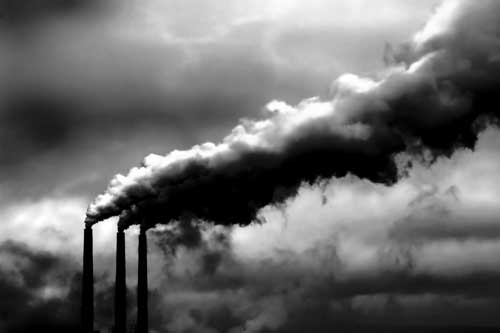EPA Expands Smog Regulations
Environmental advocates, business lobby at odds over new rules.

Smokestacks. Photo from NASA.
The U.S. Environmental Protection Agency is expanding the list of areas that will need to meet federal smog regulations along Lake Michigan in Wisconsin. The revised air quality designations are a win for environmental groups, but the state’s largest business lobby argues the move will harm economic development.
The revisions are the result of legal challenges to the agency’s 2018 list of areas that weren’t meeting tougher standards for ozone pollution or smog that were put in place by the Obama administration in 2015. Clean Wisconsin was among environmental groups who sued the EPA over a pared-down list of areas that weren’t meeting those standards. As part of a federal court ruling last July, the EPA reviewed designations impacting 16 counties in seven states that included Indiana, Illinois and Wisconsin.
Those designations represented a stark contrast to a broader list of areas that the EPA had originally proposed in 2017. The 2018 decision excluded all of Waukesha, Washington and Racine counties, which were originally included.
Late last month, the EPA restored most of the agency’s original designations in Wisconsin. All of Milwaukee and Ozaukee counties will need to meet tighter emissions limits, but only parts of Washington, Waukesha and Racine counties. A larger portion of Sheboygan, Manitowoc, Door and Kenosha counties will also face stricter ozone regulations.
“Facilities that emit pollution in southeastern Wisconsin may be subject to requirements — more requirements — that they reduce their air emissions, which will have a positive outcome for the people who live in that part of the state,” said Katie Nekola, general counsel for Clean Wisconsin. “I think it’ll improve air quality, and it will reduce the incidence of respiratory illness in those counties.”
Ozone pollution often occurs in the summer when air pollutants like nitrogen oxides and volatile organic compounds from industry, power plant or vehicle emissions interact with heat and sunlight. Smog can worsen asthma and increase the risk of chronic health issues like emphysema or lung cancer.
“You have a lot of people who live or recreate along the shorelines who certainly think that they’re probably breathing the most pristine air when it comes in off the lake, but, in many cases, that’s where some of the highest levels of ozone can be found,” said Ann Jaworski, a staff attorney with the Environmental Law and Policy Center.
In 2015, the Obama administration created a standard for ozone pollution at 70 parts per billion — a stricter standard than the previous 75 parts per billion threshold that was implemented following a review launched in 2008. The EPA must designate an area as “nonattainment,” or not meeting the standard, if it has an air quality monitor that exceeds the ozone threshold or if emissions sources contribute to a violation of federal air quality standards in a nearby area.
The revised air quality designations could mean costly pollution controls for industries whose emissions exceed those standards. Under the EPA’s changes, the Foxconn plant in Mount Pleasant will fall within an area that will be subject to tougher smog regulations. The plant was expected to be a major new source of emissions, according to the Milwaukee Journal Sentinel. The project has since been scaled back.
In the July ruling, a federal judge with the District of Columbia Circuit Court questioned the data and justifications that EPA relied on for its air quality designations in Wisconsin. In regard to Sheboygan County, the EPA noted in its revisions that the court highlighted a “gap in logic” over its review of the state’s lake breeze analysis and another statement by the EPA that the analysis wasn’t incompatible with a finding that an area could contribute to its own ozone violations.
The DNR had recommended that all the affected counties should be found as meeting the 2015 ozone standard.
In a statement, DNR spokesperson Sarah Hoye said the agency is continuing to assess the impacts and concerns with implementing the EPA’s changes.
“The DNR will continue using sound, modern science as the foundation for our decision-making and recommendations,” said Hoye. “We are committed to working closely with affected facilities and stakeholders to help them understand and implement the new requirements imposed by the EPA in this action.”
A DNR report released last fall found the state’s air quality improved along the Lake Michigan shoreline with ozone pollution dropping 25 percent on average since 2001.
Wisconsin Manufacturers and Commerce, the state’s largest business group, considers the expansion of areas that will be forced to meet stricter ozone standards a “no-grow zone,” according to Scott Manley, the group’s executive vice president.
“It’s very, very difficult to grow any type of industrial activity in those areas if you’re talking about an industry that has any type of ozone precursor emissions,” said Manley. “So, the expanded boundaries are going to mean that more businesses, more communities are located in a no-growth zone, which is — from an economic standpoint — really unfortunate.”
Manley said WMC isn’t ruling out any legal action on the revised designations. The EPA declined to comment on its decision Wednesday.
Listen to the WPR link here.
EPA Expands Areas That Will Face Tougher Smog Regulations In Wisconsin was originally published by Wisconsin Public Radio.





















